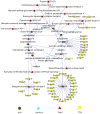Evaluating the pharmacological mechanism of Chinese medicine Si-Wu-Tang through multi-level data integration
- PMID: 24223693
- PMCID: PMC3817162
- DOI: 10.1371/journal.pone.0072334
Evaluating the pharmacological mechanism of Chinese medicine Si-Wu-Tang through multi-level data integration
Abstract
Si-Wu-Tang (SWT) is a Traditional Chinese Medicine (TCM) formula widely used for the treatments of gynecological diseases. To explore the pharmacological mechanism of SWT, we incorporated microarray data of SWT with our herbal target database TCMID to analyze the potential activity mechanism of SWT's herbal ingredients and targets. We detected 2,405 differentially expressed genes in the microarray data, 20 of 102 proteins targeted by SWT were encoded by these DEGs and can be targeted by 2 FDA-approved drugs and 39 experimental drugs. The results of pathway enrichment analysis of the 20 predicted targets were consistent with that of 2,405 differentially expressed genes, elaborating the potential pharmacological mechanisms of SWT. Further study from a perspective of protein-protein interaction (PPI) network showed that the predicted targets of SWT function cooperatively to perform their multi-target effects. We also constructed a network to combine herbs, ingredients, targets and drugs together which bridges the gap between SWT and conventional medicine, and used it to infer the potential mechanisms of herbal ingredients. Moreover, based on the hypothesis that the same or similar effects between different TCM formulae may result from targeting the same proteins, we analyzed 27 other TCM formulae which can also treat the gynecological diseases, the subsequent result provides additional insight to understand the potential mechanisms of SWT in treating amenorrhea. Our bioinformatics approach to detect the pharmacology of SWT may shed light on drug discovery for gynecological diseases and could be utilized to investigate other TCM formulae as well.
Conflict of interest statement
Figures


References
-
- Zhao J, Jiang P, Zhang W (2010) Molecular networks for the study of TCM Pharmacology. Brief Bioinform 11: 417–430. - PubMed
-
- Li S, Zhang ZQ, Wu LJ, Zhang XG, Li YD, et al. (2007) Understanding ZHENG in traditional Chinese medicine in the context of neuro-endocrine-immune network. IET Syst Biol 1: 51–60. - PubMed
-
- Chan E, Tan M, Xin J, Sudarsanam S, Johnson DE (2010) Interactions between traditional Chinese medicines and Western therapeutics. Curr Opin Drug Discov Devel 13: 50–65. - PubMed
-
- Cheung F (2011) TCM: Made in China. Nature 480: S82–S83. - PubMed
Publication types
MeSH terms
Substances
LinkOut - more resources
Full Text Sources
Other Literature Sources
Miscellaneous

